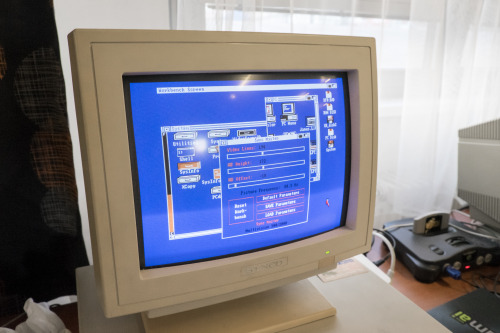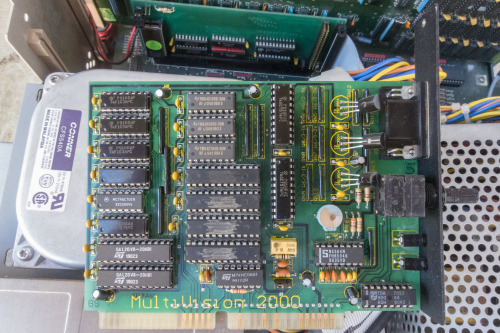Multivision 2000 (Amiga scan-doubler)Working with old Amiga computers with their original color moni
Multivision 2000 (Amiga scan-doubler)Working with old Amiga computers with their original color monitors is always a painful experience. Especially here in Europe where these screens run at 50Hz. Fortunately, my Amiga 2000 is equipped with a Multivision 2000 scan-doubler card that not only doubles H-sync from 15.75kHz to 31.5kHz (to make the output compatible with VGA monitors) but it also allows a user to increase refresh rates up to 100Hz.I wanted to show this computer on Bytefest (a vintage computer show) and I decided to show it with a CRT (LCDs always ruin the experience). That created an ideal situation to check how this “software controllable refresh rates” feature works. The manufacturer of the card (3-State) bundled a diskette with a simple program that allows you to find the optimum refresh rate using multiple sliders and the way it works is compatible even with old simple VGA screens from the early 1990s.The picture frequency is increased when a user decreases the number of video lines. Speed of drawing of each line is still the same. The computer just generates fewer lines, which means that a single frame takes less time and the next one can start sooner.I switched Workbench into the interlaced mode (512 lines instead of 256) and then used the bundled Sync Master tool to decrease the number of lines close to the original non-interlaced resolution. As a result, I got nice and steady 80Hz on a standard VGA screen, which allowed me to work with the computer for hours without eye strain. This is a perfect setup for office/productivity work. However, be prepared that this tool doesn’t work well with applications that open their own screens a display outside Workbench (you need to revert it to default before starting such application). -- source link
Tumblr Blog : swarmik.tumblr.com
#scan-doubler#multivision#vintage computer

